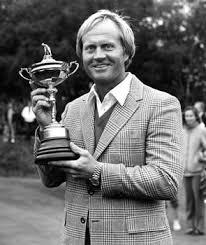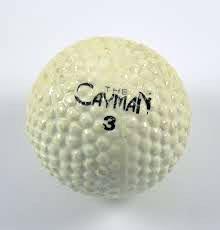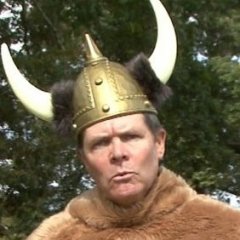Nicklaus Was Right
 Jack Nicklaus offered golf the most logical, realistic and achievable strategy for the future of the game and golf "experts" pooh-poohed it.
Jack Nicklaus offered golf the most logical, realistic and achievable strategy for the future of the game and golf "experts" pooh-poohed it.
Instead of Jack's sensible concept, today we have turf skateboards, gyro-balanced scooters, commode-sized putting cups, golf-themed singles bars/driving ranges, hybridized soccer-golf and big-budget recruitment programs that probably benefit ad agencies more than golf.
The result: A splintered approach that leaves actual golf in fragments, with clueless mainstream media pronouncing us dead.
What we need to do is band together and lead the way back to actual golf, real golf, the rugged athletic game of strategy that existed before it was hornswoggled by TV, money wizards, real-estate barkers and unemployed NASA Skunk Works engineers turned stick and ball enhancers.
ROCKBOTTUM CC THEORY #1:
The real problem with golf began when the tried and true system of golfer creation/initiation, (the entry-level golf course consisting of Mom and Pop, scruffy munis and affordable low-level country clubs) was stomped into irrelevance by a wave of acquisitors leading the CCFAD invasion.
Suddenly, the price of golf went up, as TV brainwashed the golfer to demand English country garden conditions. This is not anecdotal. A new owner of a course I was resurrecting told me his intentions were to bump the green fees up from $16 to $80 because everyone else was doing it. I just needed to make us look more like "The Masters".
Golf courses were no longer acceptable if they were more about playing the game than achieving the look of an air-brushed Playboy centerfold. The entry-level course, once responsible for introducing the new golfer to the game and helping begin the player's ascension to elite club member, was made the subject of ridicule. The conditions of a "Major" tournament course in the 70s soon became the "goat track" of the 90s.
The new golfer then found the way to earning golf's black belt was through $40 green fees, rather than the $8, play all day rate. (Try explaining that expense to the family holder of the check book, especially if you want to play twice a week.)
Courses narrowed, just like TV golf. Rough deepened, the game became claustrophobic and constricting, length increased due to shaft science, trampoline faces and ball wizardry.
Combined with other stresses on the golfer's time, like media-inflicted parental guilt and both Mommy and Daddy required to work full-time to pay for travel team soccer, the super-sized version of golf became too big an investment of time and money.
THE NICKLAUS SOLUTION
In '89, as we finished up a rebuild on a real-estate course that should have been a bass-fishing tournament site, Dad was approached by a fellow who had 40 acres in Buckhead, Atlanta's holy business/nightlife zone. Investor guy asked if we could build an executive course on the property, so I took a quick look. I saw great potential . . . for lawsuits. (The kind involving broken windshields, broken office windows and broken facial bones.)
But I did have a positive suggestion as a result of several days of testing and research. I bought a bunch  of Cayman balls--the limited flight ball produced for Jack's Grand Cayman project--and after a long day of bentgrass cursing, I challenged Dad to a match. With the Cayman ball, we played our par 3s as par 4s, teed up in the fairway at about 350 yds to create a par 5 and anywhere from 40 yds out became a par 3.
of Cayman balls--the limited flight ball produced for Jack's Grand Cayman project--and after a long day of bentgrass cursing, I challenged Dad to a match. With the Cayman ball, we played our par 3s as par 4s, teed up in the fairway at about 350 yds to create a par 5 and anywhere from 40 yds out became a par 3.
It was huge fun. Nine holes went by in 45 minutes or less, and we didn't need many clubs. An added bonus: The ball was non-lethal. It was possible to stand 150 yds downrange and catch a ball hit by a driver with a barehanded grab. We tested the ball on Dad's truck windshield, our shop windows and each other.
It quickly became an afternoon routine as Uncle Virgil--who was later killed by golf--joined us for quick golf. The ball sat up well on scruffy turf, it floated on water and acted like a normal ball around the green. It even gave me a chance to toy with some old hickory clubs. The ball had a tendency to balloon a bit in the wind, so I went back to hardpan-style low punch shots. I became smoother, as the ball did not respond to the Feet, Ass and Head swing.
I was fascinated with the idea of a short 18-hole course, built on angles like a shrunken big course; kids and beginners could learn the game in a low stress environment and the time-deprived businessman could squeeze in a lunchtime round. The course wouldn't require the heavy equipment and infrastructure investment of a full size course and in certain blasphemous situations, plastic turf could sub for tee areas.
Fast, inexpensive golf.
I got shot down. I don't know for sure, but I bet that 40 acres is asphalt and glass right now.
With the right brains, the limited flight ball could be a very positive influence on golf. Architects could take 9 holes of a superball course and create a wildly entertaining 18 hole limited flight course, leaving the remaining 9 holes for . . . condos, green space or maybe a water park.
There are plenty of golf course architects out there who could surgically transform a dying real-estate bait course left over from the artificial growth surge. It could be a sanctuary for quick golf, beginner golf and a terrific foundation for players who want to earn their black belt and graduate up to the big course on weekends.
I think we should thank Jack for offering this brilliant solution to golf's weakening state and I hope the industry will consider this suggestion, in hopes we can stop the splintering and get back together.
Or, we can just keep doing what we've been doing, cause it's working so well.



7 Comments
Recommended Comments